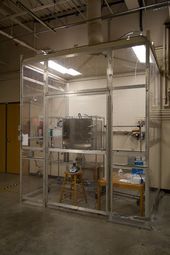Highlight
IGERT Trainee Advances Knowledge of Human Exposure to Toxic Chemicals in Moth Repellents and Deodorizers
Achievement/Results
The National Science Foundation’s (NSF) Integrative Graduate Education and Research Traineeship (IGERT) program in Indoor Environmental Science and Engineering at The University of Texas (UT) has allowed several trainees to advance the state of knowledge related to human exposure to a wide range of toxic chemicals in buildings. Trainee Priscilla Guerrero (Environmental Engineering) is studying human exposure to p-dichlorobenzene (p-DCB) and naphthalene emitted from moth repellents and, in the case of p-DCB, also some toilet and room deodorizers. The importance of p-DCB was underscored by an IGERT trainee alumnus (Dr. Diana Hun, Architectural Engineering) who estimated cancer risks associated with p-DCB in homes of many Mexican Americans to exceed those of radon action levels by a factor of four, dwarfing almost all other quantifiable environmental cancer risks. Furthermore, a recent study lists p-DCB and naphthalene as two of the nine most important indoor air pollutants with respect to health risks to humans.
Trainee Guerrero has done extensive tests on several of the most common consumer products that emit p-DCB and naphthalene, determining their emission dynamics over weeks to months under conditions typical of indoor environments into which these products are placed. Based on these results she predicted indoor concentrations for various home characteristics and verified estimates by trainee alumnus Hun. Since products that contain p-DCB and naphthalene are often used near clothing, trainee Guerrero than embarked on a novel set of experiments to understand the extent of clothing contamination by each chemical at concentrations in air that are consistent with mathematical predictions and observations for various environments in which relevant products are used. She designed and constructed a new system into which dozens of specimens of cotton, polyester, and wool are suspended in a 300-L chamber and exposed for up to a month to target concentrations of p-DCB and naphthalene. After a month some of the clothing specimens are treated by chemical extraction to determine contaminant mass per mass of fabric. Additional specimens are placed in closets in the UTest House, a 3 bedroom/2 bath test house constructed with NSF IGERT funds, to ascertain rates of desorption of contaminants over time; this is done by sequential extractions of specimens over several weeks.
Results of trainee Guerrero’s fabric experiments show large differences in the degree of contamination between fabric types. For the same exposed gas concentrations the degree of contamination on polyester is approximately 3 to 4 times greater than on wool and 10 times greater than on cotton. For polyester, new fabric adsorbs less contaminant than does worn (for one day) fabric, presumably due to additional sorption to skin oils, and recently washed polyester leads to statistically higher contamination, presumably due to residual detergent components to which p-DCB and naphthalene adsorb. Trainee Guerrero will next complete an analysis of secondary exposures to these two chemicals when contaminated clothing is worn. Thermal manikins will be used to study desorption from contaminated clothing and subsequent time-dependent concentrations in the breathing zone. An analysis of elevated concentrations of each chemical in the air space between clothing and skin will also be completed and used as input to a model to predict the importance of dermal uptake relative to inhalation uptake.
Address Goals
Trainee Guerrero’s research is novel on several fronts, and is therefore advancing the frontiers of knowledge related to human inhalation and gas-to-skin exposure to toxic chemicals. Her research is unique in terms of (a) determining actual emission rates of p-DCB and naphthalene from most relevant household products, (b) estimating contamination of clothing fabrics, and © using results to estimate secondary inhalation and gas-to-skin exposures when contaminated clothing are worn. Her results to date are highly original and reflect discovery with respect to secondary exposure to two very important toxic chemicals that largely originate in homes.
Trainee Priscilla Guerrero’s participation in this study was made possible by the flexibility afforded by the IGERT program. She became aware of trainee alumnus Hun’s work while attending an annual meeting of the IGERT program in Indoor Environmental Science and Engineering, and her own research has evolved into a robust dissertation. This goes to the strategic goal of learning, and shows how IGERT programs can catalyze research sequences that address important societal problems.






